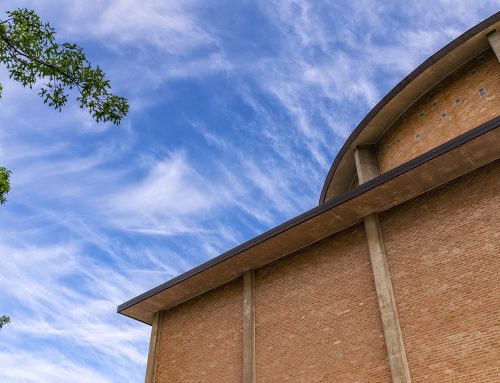On July 12, 1956, Dallas Mayor R. L. Thornton used an oversized pair of garden shears to cut a royal purple ribbon and, in doing so, made Preston Hollow history.
They called it a “Gala Celebration,” and that’s just what it was. The party lasted three days, complete with a political rally, live music, a Miss Preston Royal beauty pageant and prizes ranging from comic books to an all-expense-paid trip to Mexico City.
As the Dallas Morning News reported at the time, the center was ready to “service the thousands of families in the vast area north of Northwest Highway.”
Vast area to the north? Hard to imagine our neighborhood, now virtually bereft of vacant land and considered centrally located, ever fitting that description. But in the 1950s, some still considered this area “way up” north, probably because things were changing so quickly in those years.
Long-time residents remember the ‘50s as a time of dramatic growth and achievement for Dallas. Business was booming, as the city established itself as a wholesale trade and technology center. And the population was flourishing also, growing by more than 50 percent in a single decade.
George F. Mixon, a residential developer at the time, knew families moving into the new homes he was building would want neighborhood retail. Mixon’s project at Preston and Royal began in 1953, when he built a service station, a 7-Eleven and his office at the intersection’s northeast corner.
In 1956, Mixon expanded his development on the north end of that same property, providing space for 10 additional merchants and prompting the “Gala Celebration.” The next year, he opened the building on the east end of the property, completing the center and adding space for another 16 tenants.
The growth, of course, didn’t stop there. In September 1959, Henry S. Miller Jr. and Trammell Crow opened Preston Royal Village across the street, on the northwest corner. Miller and Crow’s Village offered many of the same services as the existing center, with the added attraction of a movie theater.
The Preston Royal Theater was the first “hardtop” theater built in the area since the end of World War II, Miller says, due to the popularity of drive-in theaters in the 1950s. Movie tickets were 35 cents, and soft drinks cost 12 cents.
Carol Short, vice president of public affairs for the North Dallas Chamber of Commerce and a longtime Preston Hollow resident, recalls The Alamo being especially popular at the theater. When crowds filed in, she says, seats filled quickly. But people kept coming, sitting in the aisles or standing in the back, to see John Wayne and friends defend the Texas landmark.
In 1965, more change was in store for the center. Miller and Crow bought Mixon’s development, with the two centers being managed together by Henry S. Miller Interests ever since. Miller says that year was also memorable because it was the only time that Preston Royal Village ever experienced a downturn in its annual sales. NorthPark Center opened, and he says people wanted to experience the novelty of the new mall.
Today, most of us know the center pretty well. But what was shopping at the 1950s version of Preston Royal like? In some ways, much like it is now.
Had you set out to run an errand at the new center in 1956, you would have found a variety of shops and services. Holiday Cleaning offered modern dry-cleaning equipment. People shopped for children’s clothes at Deb ‘n’ Heir, groceries at Wyatt’s, and hungry shoppers lunched at RoyalBurger.
At night, Preston Hollow residents often packed into the Safari Steak House for dinner. The restaurant featured murals of Bengal tigers and, according to newspaper ads, food prepared with “exotic Indian curries.”
Miller says much of the center’s success is due to maintaining a mix of shops and services similar to those offered when the center first opened.
Short agrees, saying she thinks the combination of retail anchors such as Tom Thumb, a post office branch and a variety of specialty shops keeps people coming back.
“Even people who have moved to other parts of the city still come over to Preston Royal to shop,” she says. “Where else can you get a scoop of ice cream and then walk across the street and buy a fur at Lester Melnick?”
Lester Melnick opened his women’s clothing store in 1962, occupying about 2,000 square feet. He expanded a year later and opened Young Ideas, a juniors shop. Young Ideas also sold uniforms for the Hockaday School, says Leslie Diers, Melnick’s daughter. In fact, she says, Melnick helped re-invent the private school’s wardrobe.
Today, Lester Melnick has grown to 25,000 square feet and includes Leslie’s, which caters to young working women, and LM Furs.
Across Preston, the tradition of family business continues at Covin’s Furniture. In 1974, Forrest and Toni Covin bought the House & Table store, one of the original shops in the development. The store was a small space specializing in tabletop and home accessories when the Covins bought it, says daughter Brooke Covin. The family changed the name to Covin’s Furniture in 1981 and expanded as adjacent businesses closed. Then in 1998, Brooke opened Haute Dogs and Fat Cats, a store specializing in pet accessories and gourmet treats.
Though new stores have come and gone over the years, many residents still remember the old favorites. When Diers tells her children what Preston Royal was like when she was a kid, she tells them about the T.G.&Y. She finds it difficult to describe what a dime store was like, she says, because they just don’t exist any more.
“We used to go in there to buy the big, flavored gum balls and the long pieces of red licorice, and at the same time that is where I went to buy ribbons for my hair. You could also find thimbles and things for sewing,” she says.
Diers also likes to tell her children about Fran’s Lingerie.
“Fran would close her store for the entire month of July every year and put up a sign that read: Gone Fishing,” she says. “Who ever heard of such a thing in retail?”
Despite the changes, some traditions continue. Kids of all ages used to gather at the soda fountain at Airway Drugs. While the soda fountain is gone, Dougherty’s Airway Pharmacy still thrives in its original location. And, ironically, people now rent Blockbuster movies from the very space that once housed the old movie theater.
Miller and company seem to have hit on a business mix that works. Not surprisingly, Miller doesn’t anticipate major changes to Preston Royal any time soon. There will always be incremental change and improvements, he says, and the company performs periodic studies to ensure shoppers are happy and parking and traffic aren’t causing problems. But otherwise, he plans to maintain the tenant mix that makes the shopping center such a significant part of the neighborhood.
As they say: “The more things change…”






